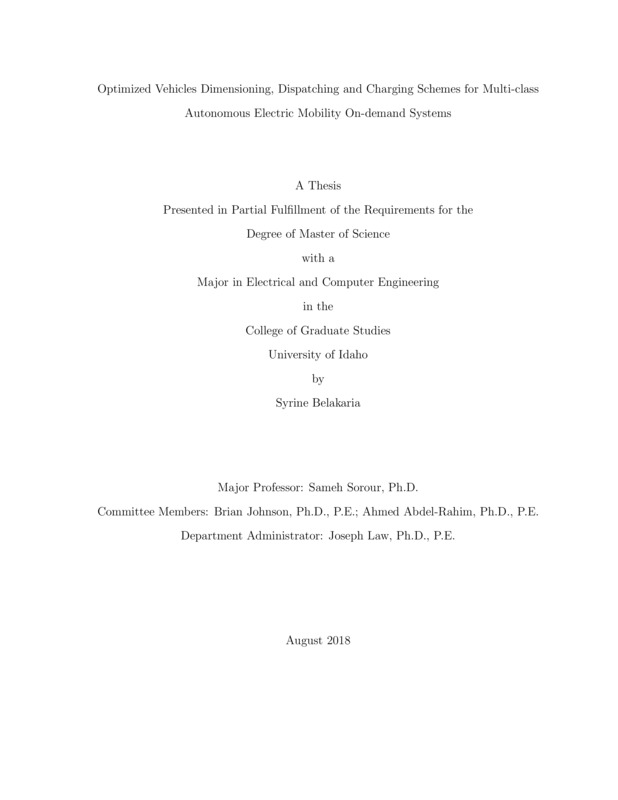Optimized Vehicles Dimensioning, Dispatching and Charging Schemes for Multi-class Autonomous Electric Mobility On-demand Systems
Belakaria, Syrine. (2018-08). Optimized Vehicles Dimensioning, Dispatching and Charging Schemes for Multi-class Autonomous Electric Mobility On-demand Systems. Theses and Dissertations Collection, University of Idaho Library Digital Collections. https://www.lib.uidaho.edu/digital/etd/items/belakaria_idaho_0089n_11417.html
- Title:
- Optimized Vehicles Dimensioning, Dispatching and Charging Schemes for Multi-class Autonomous Electric Mobility On-demand Systems
- Author:
- Belakaria, Syrine
- ORCID:
- 0000-0002-0761-0886
- Date:
- 2018-08
- Keywords:
- Autonomous Mobility On-Demand Electric Vehicles Queuing Systems
- Program:
- Electrical and Computer Engineering
- Subject Category:
- Transportation; Electrical engineering
- Abstract:
-
Despite the significant advances in vehicle automation and electrification, the next-decade aspirations for massive deployments of autonomous electric mobility on demand (AEMoD) services in big cities are still threatened by two major bottlenecks, namely the communication/computation and charging delays. In order to target the communication/computation delays, the thesis suggests the exploitation of fog-based architectures for localized AEMoD system operations. These emerging architectures are soon-to-become widely used, allowing for all localized operational decisions to be made with very low latency by fog controllers located close to the end applications (e.g., each city zone for AEMoD systems). As for the charging delays, an optimized multi-class charging and dispatching management model, with partial charging option for AEMoD vehicles, is developed for each of these zones as a queuing system. The stability conditions of this model and the optimal number of classes are then derived. Decisions on the proportions of each class vehicles to partially/fully charge or directly serve customers are optimized to minimize the maximum and average system response times. The study of the model covered also finding the optimal vehicle dimensioning for each zone in order to guarantee a bounded need of vehicles with a bounded response time. This study aimed also to resolve a clear and unrealistic limitation in the first proposed model, namely the matched charge-to-trip only service, by enabling sub-class service; i.e., allowing vehicles to serve customer classes with trips needing less charge. A queuing model representing the new multi-class management scheme is introduced. Its stability conditions are then derived. Decisions on the proportions of each class's vehicles to charge and to partially/fully charge, or directly serve customers with sub-class service are then optimized in order to minimize the maximum response time of the system. Both of the proposed models were simulated and results show the merits of our proposed models and optimized decision schemes compared to several non optimized schemes.
- Description:
- masters, M.S., Electrical and Computer Engineering -- University of Idaho - College of Graduate Studies, 2018-08
- Major Professor:
- Sorour, Sameh
- Committee:
- Johnson, Brian; Abdel-Rahim, Ahmed
- Defense Date:
- 2018-08
- Identifier:
- Belakaria_idaho_0089N_11417
- Type:
- Text
- Format Original:
- Format:
- application/pdf
- Rights:
- In Copyright - Educational Use Permitted. For more information, please contact University of Idaho Library Special Collections and Archives Department at libspec@uidaho.edu.
- Standardized Rights:
- http://rightsstatements.org/vocab/InC-EDU/1.0/

